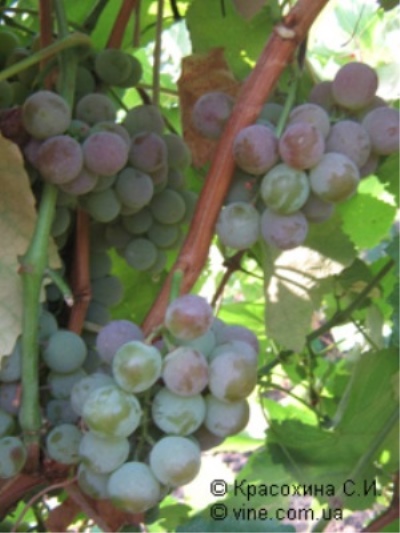
- Authors: I.V. Michurin
- Appointment: universal
- Berry color: dark red, with a purple tint
- Taste: isabelle, labrus
- Ripening period: early
- Ripening period, days: 128
- Frost resistance, ° C: -30
- Yield: 70-80 c / ha
- Flower type: functionally female
- Density of the bunch: medium density
Grapes are a popular plant that is in demand not only among experienced, but also among novice gardeners. Moreover, there are a lot of disease-resistant varieties that do not require special care. These include the Russian Concorde.
Breeding history
The history of the Concorde grape variety began with the creation of the American version. Domestic breeders combined this species with the Amur variety. Thus, juicy and sweet berries with an interesting taste acquired frost resistance and strength. The Russian Concorde was bred in the middle of the twentieth century, and very soon the variety gained popularity and spread throughout the country. It can be bred both in central Russia and in the north.
Description
The Russian Concord variety belongs to the table and wine variety. The visual characteristics are as follows:
the bush is strong, powerful, actively growing;
the type of vine is liana-shaped, so they are often used to decorate arched and other structures;
foliage is large, dissected type, but weak, powerful pubescence is present below;
the top of the foliage has a glossy wax-type bloom;
the skin is dense;
functional flowering of the female type;
the notch of the petiole is open, the bottom is sharp in appearance and resembles a lyre;
shoots are formed actively, in large quantities;
resistance to frost, diseases and pests is high.
Ripening period
The ripening period for this variety is average. The ripening period from the formation of the bud to the berries reaching maturity is on average 128 days.
Bunches
In this variety, the bunch is of medium size, occasionally it is large, the shape is cylindrical. Bunches of branchy type, their density is average.
Berries
The fruits of the Russian Concorde are distinguished by the following characteristics:
the berry is fleshy, very juicy;
round shape;
the skin is medium in density;
the color of the fruit varies from pinkish to dark red with a tinge of a violet palette, gradually the color fades into a dark blue;
the seeds and skin contain medicinal resveratrol.
Taste
Russian Concord belongs to dining and wine ones, the taste is bright, rich, with an isabelle-strawberry flavor. The fruits are quite sweet, the aroma is similar to Isabella, in addition to the strawberry notes, there are notes of black currant. Exquisite taste and aroma make this variety a great dessert.
Yield
Yields range from 4 to 6 kg per bush. From one hectare it is about 70-80 centners. The high yield allows for the cultivation of grapes on an industrial scale.


Growing features
The Russian Concord variety grows actively, the vine is like a liana, therefore it is most often grown in an arched way. Therefore, this variety is often used for landscaping. Concord belongs to the decorative varieties. There are several mandatory grooming procedures.
Watering. The Russian Concorde is moistened when disembarking, after which the soil is mulched. At the same time, it is not necessary to loosen the earth to retain moisture. Dryness of the soil is not allowed, but overflow will lead to sad consequences - the taste of the berries deteriorates, the plant begins to ache. Therefore, this variety cannot be sprayed.
Top dressing is required in the first year after planting in the form of organic matter and mineral complex. After that, you can forget about fertilization for three years, and then add organic fertilizing. Mineral fertilizers can be administered once a year in dissolved form. Foliar top dressing is excellent.
As for regular maintenance, you should weed the bushes on time, this is quite enough.
Landing
The choice of a site for planting this variety is very important; the southern and southwestern zones are suitable for the Russian Concorde. There should be fences, buildings nearby. Disembarkation is carried out in different ways. For trenching, you need to form a depression starting from north to south. This variety grows well on light and fertile soil types.
The variety is not too picky about the quality of the soil. At the bottom of the trench, drainage is formed in the form of broken bricks, chopped brushwood, then a layer of soil and manure flavored with a mineral composition is laid. The pit is formed about 1 meter by 1 meter, at a distance of 2 m from each other.

Pollination
Since the variety is functionally feminine, pollination is required. Lilia and Metallicheskiy varieties are most often planted as pollinators.
Pruning
Prune the variety in the fall, after the bush has dropped the foliage. And you need to wait a couple of weeks or more before you start pruning. In the spring, the procedure is carried out before the buds open.



Frost resistance and the need for shelter
Excellent for northern regions due to its frost resistance. Russian Concord does not require shelter for the winter, as it tolerates cold temperatures well down to minus 30 and below. A variety of non-covering type, which facilitates the organization of care.

Diseases and pests
Resistance to the main grape diseases and pests in this variety is high. Preventive measures are practically not required, it is better, in fact, to deal with ailments. The variety is also of little interest to pests, as well as to birds, due to its dense skin.

If a grape is exposed to any disease or insect, this always affects its appearance.
Storage
This variety is transportable, therefore it is grown on an industrial scale. It is stored well, it is used fresh or in processed form - as juice, marinade.











































































